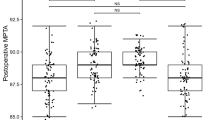Abstract
Background
Patients with obesity have an increased risk of osteoarthritis of the knee, which can lead to the need for total knee replacement (TKR). TKR may be more complex in obese patients and the correct orientation of the implant is more difficult. We selected patients with body mass index (BMI) >35 kg/m2 undergoing TKR and studied the utility of an intramedullary tibial cutting guide in facilitating the correct orientation of the tibial implant.
Methods
Seventy patients with BMI >35 kg/m2 were selected for a prospective, randomized study. Patients were divided into two groups: In group 1 (n = 31), the tibial component was implanted using the aid of a intramedullary tibial guide. In group 2 (n = 39), the tibial component was implanted using the aid of an extramedullary tibial cutting guide.
Results
The two groups were comparable with respect to age, BMI, and degree of preoperative deformity. Mean age was 69.35 in group 1 and 70.06 in group 2. Group 1 had a mean BMI of 39.84 kg/m2 and group 2 of 40.05 kg/m2. Postoperative orientation of the femur and tibia and the mechanical axis were within the normal range in both groups. A statistically significant difference between the two groups was observed in tourniquet time, which was longer in group 2 than in group 1 (p = 0.038).
Conclusion
Two types of guide were compared in correctly orienting the tibial component of the TKR in patients with a BMI >35 kg/m2. The lesser tourniquet time in the group in which the intramedullary guide was used suggest its usefulness because the positioning and orientation of the tibial cut was carried out more rapidly and anatomical references were not needed for correct orientation, as it is guided by the anatomical axis of the tibia. The use of the intramedullary guide reduces surgical time in these patients.






Similar content being viewed by others
References
Guss D, Bhattacharyya T. Perioperative management of the obese orthopaedic patient. J Am Acad Orthop Surg. 2006;14:425.
Miric A, Lim M, Kahn B, et al. Perioperative morbidity following total knee arthroplasty among obese patients. J Knee Surg. 2002;15:77.
Namba RS, Paxton L, Fithian D. Obesity and perioperative morbidity in total hip and total knee arthroplasty patients. J Arthroplasty. 2005;20(Suppl 3):7.
Rottman SJ, Dvorkin M, Gold D. Extramedullary versus intramedullary tibial allignment guides for total knee arthroplasty. Orthopedics. 2005;28:12.
Winarsky R, Barth P, Lotke P. Total knee arthroplasty in morbidly obese patients. J Bone Jt Surg Am. 1998;80:1770.
Krushell RJ, Fingeroth RJ. Primary total knee arthroplasty in morbidly obese patients: a 5- to 14-year follow-up study. J Arthroplasty. 2007;22(Suppl 1):77–80.
Foran JRH, Mont MA, et al. Total knee arthroplasty in obese group. J Arthroplast. 2004;19:817.
Spicer DD, Pomeroy DL, et al. Body mass index as a predictor of outcome in total knee replacement. Int Orthop. 2001;25:246.
Foran JRH, Mont MA, et al. The outcome of total knee arthroplasty in obese patients. J Bone Jt Surg Am. 2004;86:1609.
Devanshu K, Markel D. The effect of posterior tibial slope on range of motion after total knee arthroplasty. J Arthroplast. 2006;21:809.
Moreland JR, Hungerford DS, Insall JN, et al. Symposium total knee instrumentation. Contemp Orthop. 1988;17:126.
Author information
Authors and Affiliations
Corresponding author
Rights and permissions
About this article
Cite this article
Lozano, L.M., Segur, J.M., Maculé, F. et al. Intramedullary versus Extramedullary Tibial Cutting Guide in Severely Obese Patients Undergoing Total Knee Replacement: A Randomized Study of 70 Patients with Body Mass Index >35 kg/m2 . OBES SURG 18, 1599–1604 (2008). https://doi.org/10.1007/s11695-008-9564-1
Received:
Accepted:
Published:
Issue Date:
DOI: https://doi.org/10.1007/s11695-008-9564-1




